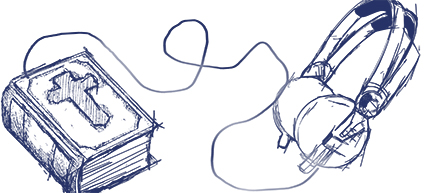Advancing Scripture Access for Discipleship Among Bible-less Oral People

Foundational to making disciples in every people group is enabling access to and engagement with the Word of God in their own language. This awareness has fueled initiatives by some translation agencies to begin translation of the Bible into every language by the year 2025. A high percentage of Bible-less people groups are oral learners, yet the whole Bible in audio is only available in fewer than 130 of the world’s 6800 languages. How are oral communities to be discipled, and how are movements of indigenous fellowships to be sustained among them without access to the whole Bible in a format they understand? In the words of Samuel Chiang, mission history has shown that “no church planting movement has been sustained long term without access to the whole Bible.”
With this as a backdrop, consider the following three springboards for advancing scripture access and discipleship among Bible-less oral people.
Collaboration Beyond Our Silos
 Excellent work has been done historically by Bible translators, often at great personal sacrifice, to translate and print the Bible in new languages. Missionaries have labored to reach the most remote and isolated unreached people groups, and indigenous workers have accessed those who no foreigner could reach. Yet many times these efforts have taken place within either denominational/ organizational or discipline-related silos and as a result, the outcomes, though both laudable and extensive, have not always attained their greatest potential. For example, at times translators have provided print Bibles to populations of oral learners who could not read them and where there were few believers and fewer laborers, while in a nearby people group there were numerous new believers and sufficient laborers but no Bible in the local language whether printed or recorded.
Excellent work has been done historically by Bible translators, often at great personal sacrifice, to translate and print the Bible in new languages. Missionaries have labored to reach the most remote and isolated unreached people groups, and indigenous workers have accessed those who no foreigner could reach. Yet many times these efforts have taken place within either denominational/ organizational or discipline-related silos and as a result, the outcomes, though both laudable and extensive, have not always attained their greatest potential. For example, at times translators have provided print Bibles to populations of oral learners who could not read them and where there were few believers and fewer laborers, while in a nearby people group there were numerous new believers and sufficient laborers but no Bible in the local language whether printed or recorded.
Additional factors to be given consideration are that the demographics of the global mission work force are rapidly shifting both south and east; while political doors are being closed to natives of traditional mission-sending nations, laborers from the global southeast are increasingly able to access these same places and often at a much lower cost. Yet according to sources at the National Christian Foundation, approximately 75% of the financial resources of the evangelical church globally are in the hands of North Americans. The combination of the realities mentioned above leads to the conclusion that what is necessary to maximize effectiveness in enabling Scripture engagement among unreached oral learners is intentional, cross-disciplinary, interagency, and international collaboration.
The Last Command Initiative is an example of this approach. Launched by a coalition of Indian agencies and denominational entities together with international organizations, foundations and donors, it has as one of its purposes the goal, through translation of the Bible, to provide access to and engagement with scripture to every language and people group in India who are yet without the Word of God. Locally driven, this initiative has brought together prayer warriors, church planters, mother tongue translators, expert consultants, project managers, funding sources, and audio Scripture providers in a synergistic manner. This maximizes the strengths of each contributing party—local knowledge, language, access and leadership are combined with international resources and specialized expertise.
Integration of Storytelling and Audio Scripture Engagement
The orality movement has had at its core the practice of storytelling, one of the most accepted and practiced forms of learning in oral cultures. As in early times biblical truths are conveyed through the oral transmission of Bible stories. Yet even the most advanced Bible storytellers have only mastered 225 Bible stories to date. This amounts to approximately 10% of the Bible. If oral learners are to have access to the whole Bible then audio-digital formats must also be utilized. The Interactive Bible Discovery (IBD)1 method of scripture engagement for oral learners, integrates storytelling and audio Scripture engagement, thus enabling a combined oral-audio discipleship process that is easily replicated. IBD intentionally merges the communication strengths of storytelling with the advantages of audio Scripture. This method enhances accuracy and enables both replication and scalability. Interactive Bible Discovery is gaining momentum with practitioners in oral communities.
Acceleration of Scripture Availability for Oral Learners
Recently, several Bible agencies have accelerated access to the Scripture among oral learners through the simultaneous release of print and audio formats of the Bible. By planning joint release of the Bible in both formats the agencies ensure access for literate and oral learners alike. When combined with training in the Interactive Bible Discovery method and strategic planning with local leaders, approaches are put into place that target Scripture engagement for every segment of the community.
One of the challenges faced in providing Scripture access for oral learners is the length of time it takes to translate the whole Bible into a new language, which has historically taken in the vicinity of 25 years. Recent initiatives such as the use of mother tongue translation teams and translation from oral to oral, bypassing print, are shortening the time required, but a full Bible translation can still take a dozen years. The traditional approach in translation has been to begin with a few Bible stories, progressing from there to a gospel, then to the New Testament, and finally the Old Testament. So how does a new fellowship of believers nurture itself while it waits ten or 12 years for the full Bible translation? A new initiative called Bible 3-6-5 aims to provide Bible-less oral peoples the “bread of life” daily for a year in audio format through translation and recording of 365 chronological Bible passages from Genesis to Revelation. This core or golden thread of the Scripture amounts to approximately 20% of the Bible and can be translated and produced in approximately one fifth of the time. Part of the beauty of the approach is that it can be developed in several phases of story sets, each set being released as it is produced. Though there is a template of passages, the final selection is determined together with the local leadership and can be tailored to the context.
Bible-less oral people are among the least-reached peoples on the planet. Intentional collaboration across traditional boundaries combined with oral-audio Scripture engagement practices, and the acceleration of access to heart language audio Scriptures are keys to streamlining Scripture access and enabling discipleship among them.









comments